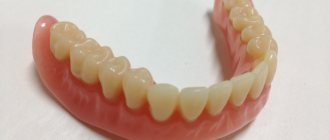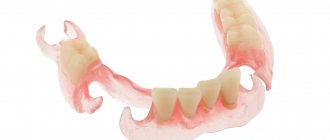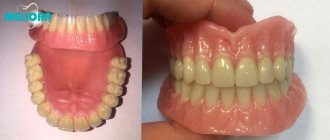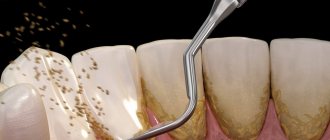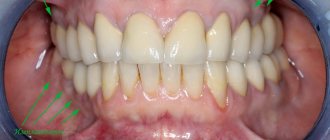- Indications
- Contraindications
- Advantages and disadvantages
- Kinds
- Clasp
- Made from nylon
- Lamellar
- Immediate dentures
- Manufacturing and installation
- Rehabilitation
- Care
- Prices
- Work examples
- Doctors
- Reviews
Despite the variety of implants, crowns and other methods of dental reconstruction, removable prosthetics does not lose demand, remaining an option for patients. Lightweight and strong structures compete with permanent dentures. This is a choice in cases where the patient cannot undergo implantation or have a fixed orthopedic system installed.
- When used:
missing from 1 tooth to completely edentulous - Type of anesthesia:
no need - Procedure time:
from 30 minutes (up to 4 visits) - Treatment period:
from 1.5 weeks to 3 weeks - Healing period:
from 3 weeks after the last removal - Age restrictions:
from 18 years old (in our clinic)
What dentures are best?
The type of system is selected individually. Taking into account the pros and cons of the designs, we draw the following conclusions:
- In case of partial loss of teeth and the presence of supporting teeth, clasp dentures will be an option. If there is an allergy to metals, choose QuattroTi dentures, acrylic, nylon models.
- If you have a toothless jaw, intolerance to acrylic and the impossibility of implantation, use plate Acry Free or nylon analogues.
Clasp dentures from 40,000 rub.
Nylon prostheses from 40,000 rub.
Lamellar dentures from 32,000 rub.
Butterfly prosthesis from 11,000 rub.
Quadrotti prosthesis from 64,500 rub.
Acri-Free prostheses from 47,000 rub.
Even with the same dental defects in two patients, prosthetics proceed differently. Only a doctor can tell which orthopedic product is the decision in this clinical situation, after examination and x-rays.
What type of prosthetics should I choose if I lose one tooth?
It is impossible to recommend any specific type of prosthetics as the best: in order to select the optimal technique, you need to study the features of the clinical case, and only a specialist can do this during the examination of the patient. Examination and diagnostics when choosing a prosthetic method are important - they allow not only to choose the optimal technology for restoring a lost tooth, but to eliminate the contraindications that each method of prosthetics has.
If you want to quickly and effectively solve the problem of tooth loss, sign up for a consultation with dental specialists in Moscow - Vanstom. Our doctors will recommend the optimal prosthetic technique and provide your treatment at the European level of quality! We are located in the center of Moscow, near the Baumanskaya metro station, you can make an appointment with us by phone or through the website services!
Advantages and disadvantages
Advantages
- Restoring the aesthetics and functioning of the dentition;
- used in complex clinical situations when reconstruction methods are impossible;
- selection of types of orthopedic products;
- installation without preliminary grinding of abutment teeth;
- variability of materials for manufacturing;
- without restrictions;
- speed of production and installation;
- repair of the orthopedic system in case of mechanical damage;
- ease of wearing and care;
- exceptional hygiene and safety;
- no age restrictions;
- use as a temporary prosthetic structure;
- service life (5-8 years);
- preservation of aesthetic indicators;
- price.
Flaws
- Restoration of chewing function is not complete;
- changes in diction, taste sensitivity during the period of adaptation;
- the likelihood of gum inflammation, irritation of the oral mucosa;
- uneven distribution of chewing loads;
- unable to stop or prevent jawbone atrophy;
- not all types of dentures and fixtures can be repaired;
- risk of damage to tooth enamel, development of cervical caries in the area where the attachments adhere to the supporting ones;
- relatively long period of adaptation;
- deformation and subsidence of the product (for metal-free structures);
- insufficient fastening on the lower jaw (applies to complete removable dentures).
The use of a bridge in the absence or loss of one tooth
This prosthetic technique is recognized as a classic: it has been successfully used by dentists for many years to solve the problem of single edentia. The procedure uses bridges that have excellent strength and aesthetics. The cost of prosthetics using this technology will be lower than the price of implantation, however, fixing a bridge always requires preliminary preparation of the teeth, which will serve as the base for its installation.
Prosthetics with a bridge will take place in several stages:
- Examination of the patient, preliminary dental treatment and sanitation of the oral cavity;
- Preparation of units that will act as a support for the installed prosthesis;
- Taking an impression for the manufacture of a prosthetic structure consisting of crowns and an artificial tooth.
Various materials can be used to produce a dental bridge. The optimal choice would be ceramics or metal-ceramics - they have good strength indicators, visually the prosthesis is almost impossible to distinguish from natural teeth. But prostheses made of metal alloys are more suitable for prosthetics in the area of masticatory units, since their aesthetics leave much to be desired.
An obvious disadvantage of prosthetics using dental bridges is the need to grind down the units that will support it. Grinding teeth has a negative impact on their condition and increases the risk of developing various diseases and destruction (with irregular care and poor oral hygiene).
Types of removable denture systems
Removable dentures – orthopedic products. They are removed and installed in the oral cavity independently. Dentures are made from biocompatible, elastic materials. Two kinds:
- Partial removable - installed if the patient is missing one or more in a row. These are plate, clasp, and immediate dentures. They are attached to supporting teeth or implants with fixing elements. Evenly distribute the load when chewing between the supports and gums.
- Full removable – in case of loss of teeth on one or both jaws. In such situations, it is impossible to secure the denture to a rigid support. Alternative fixation is used. The chewing load is placed on the gums.
Modern technologies provide strong fixation and precise fit to removable orthopedic systems. Patients note the ease of use and care.
Indications for prosthetics
As already noted, prosthetics are recommended to be performed with fixed dentures. Because they are more convenient and reliable. But is it possible to put a removable denture on 1 tooth? Of course, there are practically no contraindications here. The main list of conditions when the need for removable monoprosthetics arises is as follows:
- missing 1 tooth along with the root,
- the natural crown is completely destroyed, but the root is healthy and is being “prepared” for fixation of the stump tab with a crown: during the waiting stage, a removable denture is worn,
- an implant has been installed, but the crown has not yet been fixed on it: the healing (fusion with the bone) of a single implant can last 3-6 months, so a plug is placed on it and the gum is sutured. During this period, a temporary prosthesis is installed for aesthetics and to protect the gums from injury.
The exception is patients with absolute contraindications to fixed prosthetics or implantation. For example, in case of severe diseases of the body, poor blood clotting, intolerance to anesthesia, in childhood, during pregnancy and lactation, the “removal device” is worn for a long time on an ongoing basis.
There are certain indications for installing a removable denture on one tooth, which depend on the type of orthopedic design. Therefore, we will dwell on them in the appropriate sections.
Clasp dentures
Clasp dentures are orthopedic structures made of artificial teeth on a base replicating natural gums, fixed on a durable metal arch (clasp). They correctly distribute the load when chewing without overloading the dental system. The condition for installing a clasp structure is a sufficient number of supports (teeth or implants) to which it is attached with hooks or clasps.
Removable dentures made of nylon
A base made of thin, elastic nylon on which artificial dental crowns are attached. Products are manufactured based on the clinical situation.
- The bioinert material does not contain metal impurities and does not cause allergies
, so the structures are not removed at night. - Since the color of the base is matched to the natural shade of the gums, the design is not noticeable and looks natural
.
Among the advantages are price, speed of adaptation, convenience. The only drawback of the design is that soft nylon sags and becomes deformed. But even so, the service life is 5-8 years
.
Life time
Such a prosthesis can last from 2 months to 2 years. The service life depends on the needs of the patient, the materials used in the manufacture and the design features of a particular model.
Plastic products equipped with metal fasteners last the longest. Nylon and acrylic butterflies are not as durable due to the insufficient strength of the materials.
It is worth understanding that any prosthesis will sooner or later become unusable. They crack and begin to wobble. This can lead to injury to the jaw, so at the first sign of defects you should consult a specialist.
You can increase the service life of the product with proper care. This involves regularly cleaning your dentures with a soft brush and toothpaste. At night it is better to remove it and place it in a special container with an antiseptic. A disinfectant solution can be purchased at a pharmacy or made independently using special tablets. The antiseptic in the container must be changed regularly.
You should not remove your denture too often. This can lead to displacement of the clasps, which will cause discomfort when wearing the product.
Plate dentures
A group of prosthetic systems for partial or complete restoration. The basis of the structures is a soft base that imitates part of the oral mucosa, with artificial tooth crowns attached to it. Representatives of this group of orthopedic products are structures made from acrylic-free plastic alloy “Acry Free” and the elastic QuattroTi prosthesis.
- Partially removable QuattroTi
is an orthopedic system manufactured using 3D modeling technology. The approach ensures the fit of the structure and comfort of wearing. Elastic hook retainers do not require grinding of the supporting teeth, are invisible, and harmless to tooth enamel. - Lightweight, flexible Acry Free
made from non-allergenic composites combine appearance and comfort with service life (5 years) and price. Used for partial or complete restoration. The advantage of an orthopedic system is the ability to repair if damaged.
Made from bioinert materials, the flexible, soft base is not paintable and does not change color during service. They have a number of disadvantages, like similar orthopedic products.
Budget dental prosthetics in Moscow
The PROFI-Dent clinic offers high-quality but inexpensive dental prosthetics in Moscow, providing orthopedic treatment quickly and professionally.
The main advantages of contacting us:
- high-quality diagnostics;
- professional assistance in choosing a prosthesis;
- application of computer modeling technology in the manufacture of structures;
- all patients are monitored by a doctor until they are completely accustomed to the new prosthesis;
- only the latest orthopedic technologies and materials;
- guarantee for all types of dental services;
- free denture correction.
We are sure that a beautiful and healthy smile should not be perceived as a luxury. We do not offer the cheapest dental prosthetics in Moscow, but our prices are among the most affordable, including dentures on implants.
Immediate dentures
Removable immediate dentures - to replace defects in the dentition during the production of a permanent orthopedic system. There are three types of such models - full, partial, butterfly.
They cope with the task, return partial work to a lost dental unit and hide a visual defect. The disadvantages include fragility, fragility, and long addiction.
The absence of dental units in a row causes a lot of problems:
- articulation disorder;
- curvature of the dentition;
- malocclusion;
- displacement of dental units;
- bone tissue atrophy;
- problems with the digestive tract;
- psychological complexes.
The PROFI-Dent clinic will help you quickly restore your full smile using low-traumatic methods of dental prosthetics. The cost of dental prosthetics in Moscow in our clinic is affordable to every patient.
Manufacturing and installation of a prosthesis
Includes stages:
- Preparatory and diagnostic – after hygienic cleaning, treatment, the patient undergoes a survey x-ray, CT scan of the jaw, which requires prosthetics.
- The dentist takes an impression and sends it to a dental laboratory.
- The production of an orthopedic system lasts on average 2 weeks. New technologies for taking impressions and 3D modeling make it possible to create anatomically verified structures that reproduce the chewing surface of each element down to the smallest detail.
- The doctor tries on the finished denture for the patient and corrects any discrepancies.
The final stage is fixation of the product in the oral cavity.
Implantation of 1 tooth
The technique involves surgical intervention, which requires a careful approach at all stages. The number of doctor visits, the need for certain procedures and the duration of engraftment vary from person to person.
1
2
3
4
5
6
The diagnostic stage includes examination by a therapist, radiography (assessment of the condition of the bone, root systems of adjacent teeth), CT or tomography (assessment of bone density), orthopanorama (position of elements), consultation with a therapist and, if necessary, specialists (ENT, allergist, cardiologist, endocrinologist) .
Preparation includes sanitation of the cavity, treatment of all diseases of the dental system, and removal of elements unsuitable for restoration. Implantation is performed only on healthy patients. Colds, allergies, herptic rashes and other acute conditions can provoke rejection of the installed structure and the appearance of complications.
Bone grafting is performed when natural bone volume is lost. It is performed in several ways depending on the nature of the problem.
The surgical stage takes no more than 30–60 minutes and includes several manipulations:
- anesthesia;
- incision of the braid to access the bone;
- bed formation;
- installation of a titanium rod;
- suturing.
Osseointegration, or engraftment, into the bone takes from 3 to 6 months, depending on the location (lower or upper jaw) and the personal characteristics of the organism.
Preparing the site for installing a crown - installing a gum former. It is an intermediate stage and is carried out 3-5 months after surgery. Recovery takes 2 weeks.
Abutment fixation, impression taking, crown installation. Several fastening methods are used (adhesive material, built-in locks or screws).
If the decayed tooth or its root is not removed at the time of implantation, then a one-stage surgical protocol is possible. In this case, immediately after removal, an implant with an abutment is installed. This option is the least traumatic, as it involves only one operation. An added benefit is the preservation of gum contour for a natural-looking smile.
Possible implantation with immediate loading, when a temporary crown is installed in the smile area.
The rehabilitation period involves strict adherence to doctor's orders, restrictions on exercise, nutrition, visiting saunas and rinsing with antibacterial sprays. Discomfort and minor soreness may persist for some time.
Doctors at the Vimontale clinic use the latest implantation methods that meet the needs of patients and their financial expectations. Implantologists undergo regular training and advanced training, which allows them to work with the most complex cases with confidence in successfully solving the problem. Sign up for a free consultation and get answers to all your questions about the cost, timing and scope of the required work.
Collapse
Fixation of prostheses
Bugel, partial and full plate systems are attached to the mouth in different ways. Clasp ones are held in place with the help of clasps and attachments, partial plate ones - with soft fasteners, full plate ones - with a vacuum effect.
- Clasps
are metal hooks with which the prosthetic system clings to the base of the support units. - Attachments
are locks made of two components. One component is located on the prosthetic structure. The second is on the supporting tooth or implant. When putting on the orthopedic system, the clasp snaps tightly into place, holding the product in the mouth. - Vacuum effect
- flexible material fits closely to the gums and sticks to them. If necessary, increase the tightness of the seal, use “adhesive” pastes and gels.
Removable dentures are created using impressions from the patient. They are fixed in the mouth and do not fall out when chewing or playing sports.
Alekperov Roman Borisovich Dentist-orthopedist, doctor of the highest category
Is it necessary to remove a single tooth when performing removable dentures?
When talking about removable dental prosthetics of the lower jaw, they try to preserve their own teeth as much as possible. When replacing dentures in the upper jaw, single teeth must be removed. The decision is made by the doctor based on the clinical situation, after examination and diagnostic measures.
Alekperov Roman Borisovich Dentist-orthopedist, doctor of the highest category
There is only one tooth left on the upper jaw. Which denture should I choose so that the structure is held as tightly as possible and does not fall off?
If there is a single tooth in the upper jaw, only a partial, removable plate prosthetic system is likely to be manufactured. But such a design will not hold very firmly and in terms of reliability of fixation it is significantly inferior to prosthetics on implants. As an alternative, we recommend All-on-4, in which the denture is securely fixed to the jaw using only 4 titanium supports.
Alekperov Roman Borisovich Dentist-orthopedist, doctor of the highest category
On the left side of the upper jaw, 4 teeth in a row were lost. There are gold crowns on the lower jaw. Which removable denture is best placed on the upper jaw so that it does not conflict with the crowns?
In this case, it is possible to manufacture a partial removable lamellar denture based on acrylic or an Akri Free prosthesis. It is also possible to install the prosthesis on attachments or telescopic crowns. Since metal crowns are already present in the oral cavity, the best option would be Akri Free prosthetics.
Types of orthopedic structures
A removable denture for one tooth can be of 2 types - an immediate prosthesis or “butterfly” and a splinting clasp. They belong to partial orthopedic structures, because placed in case of partial edentia. They are placed in certain clinical situations and have different appearance (as well as purpose). Let's consider their features further.
Don't know what type of prosthetics to choose?
We will help in the selection, advise where to read more information and compare types of prosthetics.
Consultation with an orthopedic doctor in Moscow clinics is free! Call now or request a call
Working hours: from 9:00 to 21:00 - seven days a week
Immediate prosthesis or “butterfly” - characteristics, pros and cons
“Butterfly” is a removable denture for 1 tooth, which looks like a dental crown with pink “wings” or hooks on the sides (4 hooks in total). How does such an orthopedic structure hold up? With these hooks, otherwise called “clasps,” the prosthesis covers the adjacent supporting teeth and is thus fixed. The crown is made of light-colored plastic, and the hooks, which are a continuation of the base, are made of elastic or hard pink polymer. Based on the material from which the artificial gum is made, acrylic and nylon dentures for 1 tooth are distinguished. Moreover, both classic acrylic and the more modern monomer-free material Acry-free (“Acry-free”) can be used.
- indications: suitable for all groups of patients, but only if there are included row defects,
- an absolute contraindication is a terminal defect - the absence of the last molar in the row: in this case, the butterfly clasps on one side will have nothing to attach to,
- advantages: quickly manufactured, easy to install, quick adaptation,
- Disadvantages: the hooks quickly stretch, the fixation of the structure becomes worse - you have to use a special adhesive cream or change the product. Chewing function is not restored very well. They do not stop bone tissue atrophy under the crown (where there is no root). Without load, the bone decreases in size and sags, causing discomfort and decreased aesthetics.
Another contraindication is too young age (up to 2-4 years) and the presence of mental illness, epilepsy. In such situations, the patient may unknowingly swallow the structure.
Read on the topic: immediate dentures - what they are, types, advantages and disadvantages.
Clasp splinting – features, pros and cons
A clasp denture with a splinting function is similar to a traditional one in that a metal arch is placed inside its base - this frame imparts rigidity, facilitates chewing food and correctly distributes the load. Additionally, the design includes claw-shaped or ring-shaped processes made of metal, occlusal pads, with the help of which splinting of mobile teeth occurs. In the upper jaw, this design does not have a massive palatal overlap, but only a thin plate or bridge.
- indications: used for included and end defects, but only in the presence of mobility of the remaining teeth (with periodontitis and periodontal disease),
- advantages: they perform 2 functions at once - they restore missing teeth and stabilize remaining teeth. They distribute chewing pressure well, it is much more convenient to chew with them than with “butterflies”,
- disadvantages: large mass of the structure, does not stop the atrophy of the jaw bone.
How to quickly get used to a removable prosthetic system?
After installing a denture, it will take time to get used to it. To ensure that adaptation proceeds without problems, we recommend:
- Do not remove from mouth for long;
- suck on lollipops to suppress the feeling of nausea;
- read aloud to practice clear diction;
- For the first few days, follow a gentle diet.
Addiction lasts on average 2-4 weeks. If discomfort persists for more than a month, pain intensifies, gums become inflamed and bleed, you should consult a doctor.
Caring for dentures
They are not difficult to care for. All that is needed:
- Clean morning and evening with a soft brush and pastes that do not contain abrasives;
- rinse your mouth every time after eating;
- regularly treat with an antiseptic;
- give up sticky (chewing gum, toffee), excessively hard foods (nuts);
- Once every six months, take the denture to an orthopedist for cleaning and correction.
Compliance with these simple rules extends the service life and preserves the original appearance of dentures.
Article Expert
Alekperov Roman Borisovich Dentist-orthopedist, doctor of the highest category
Work experience: more than 31 years
Prices
| Service | Price |
| Removable and conditionally removable prosthetics | from 6,500 rub. |
| Installation of a temporary cosmetic plate (butterfly) | from 11,000 rub. |
| Installation of a complete or partially removable lamellar denture (acrylic, 1 jaw) | from 32,000 rub. |
| Installation of a clasp denture with clasps (1 jaw) | from 40,000 rub. |
| Installation of a partially removable nylon prosthesis (1 jaw) | from 40,000 rub. |
| Installation of a complete removable denture Akri Free (1 jaw) | from 47,000 rub. |
| Installation of a splinting clasp prosthesis (1 jaw) | from 55,000 rub. |
| Installation of a partially removable clasp prosthesis Quadrotti (1 jaw) | from 64,500 rub. |
| Installation of a locking clasp prosthesis (1 jaw) | from 70,000 rub. |
| Installation of a clasp denture on telescopic crowns (1 jaw) | from 75,000 rub. |
| Conditionally removable acrylic prosthesis on spherical attachments Rhein-83 for 1 jaw | from 121,000 rub. |
Consultation and diagnostics are free!
All prices Promotions
What teeth to put in if the jaw is completely “empty”?
Unfortunately, it also happens that a person is left completely without teeth on one of the jaws, and sometimes on both at once. What should he do in this case? Of course, you can just come to the dental clinic and ask: “I want to insert teeth - which ones are better? Tell". But it is advisable to understand at least a little about the issue of prosthetics in order to make the best choice. What does dentistry offer for complete edentia? Here are the main ways to restore teeth in this case:
- Complete removable dentures.
Very easy to install structures, which are artificial gums (base) made of acrylic or nylon with crowns fixed on it.When a patient decides to install complete removable dentures, which is better to choose - acrylic or nylon? There is no clear answer here; you need to look at the specific clinical situation and the wishes of the patient himself. In some cases, nylon is preferable, since it looks much better, is more comfortable to wear and can be installed by people in extreme professions (acrylic will not suit them, because due to its rigidity it can cause injury in the process of a fall or other unforeseen event). But sometimes it’s better to go with acrylic, which is stronger and better withstands chewing loads. When choosing removable dentures for teeth (which is better), you should ask your dentist - he will give individual recommendations.
- Prosthetics on implants.
There are several options for such dental restoration: bridge structures on implants (in case of complete edentia, they are installed in “sections”: several dentures on one jaw), removable dentures on implants (this method is especially recommended for the lower jaw, on which the usual removable structure does not hold very securely) and even clasp ones. Implantation serves as a support for the main prosthesis and makes it more reliable. If the patient is not afraid of serious stress on the body and is ready to invest a lot of money in restoring the health of his oral cavity, he can carry out a complete implantation of the entire dentition; modern technologies allow this possibility. - All-on-4.
A modern and very reliable method of restoring teeth, which is much more economical than full implantation. The essence of the method is that four implants are implanted into the jaw, on which the main structure is then installed, restoring the entire dentition.
Dental surgeon, implantologist at the 32 Dent clinic Sergey Leonidovich Yakubovsky: “We recommend All-on-4 prosthetics to patients with complete edentia as a gentle and very reliable way to regain their teeth. Full implantation is quite a serious burden on both the body and the patient’s wallet. And here there is an opportunity to restore the dentition at an affordable price, for a long time and with good aesthetics.”
Which teeth are better to insert: prices for prosthetics
Complete removable structures will cost 15-55 thousand rubles. If you plan to install them on implants, the cost of implantation will be added here, so the price will be higher - from 58 to 80 thousand rubles. All-on-4 prosthetics will cost approximately 50-60 thousand rubles (depending on the chosen main prosthetic design and types of implants).
Which dentures are best to install?
? It is advisable to at least have a rough idea of what you want when going to the dentist. And the doctor will help you navigate and choose the optimal method for a particular case, tell you about all the pros and cons of the chosen method and carry out proper installation. The main thing is to choose a good doctor!
Work examples:
All works
Restoration of both jaws with removable acrylic dentures
Conditionally removable prosthesis using a fastening system on Rhein-83 attachments
All works
Sign up for a consultation
three ROOTT specialists + diagnostics as a gift
Benefits for use
Long-term absence of teeth can lead to various dental problems. Removable dentures allow you to avoid the following:
- Displacement of adjacent teeth in a row towards the defect. This is a slow process that leads to changes in the bite. The defect accelerates when a person begins to chew food on one side of the jaw.
- Increased load on remaining teeth. The jaw quickly adapts to changing conditions. This is manifested by the reformation of functional groups in the mouth. Such repurposing leads to increased abrasion of the enamel and destruction of fillings.
- Moving the antagonist tooth towards the defect. The tooth seems to increase in size. In fact, there is no growth. It simply slides out of its own hole, since there is less load on it.
- Excessive load on the temporomandibular joint. This occurs due to changes in the bite. As a result, the TMJ becomes deformed. The patient experiences pain while chewing and difficulty opening the mouth.
- Changes in the tone of the jaw muscles. A person cannot chew food normally. It enters the stomach in large pieces, which leads to problems with the gastrointestinal tract.
One cannot help but mention psychological problems. Temporary dentures allow you to quickly restore the aesthetics of your smile. This means that the patient will not feel awkward when communicating with other people.

